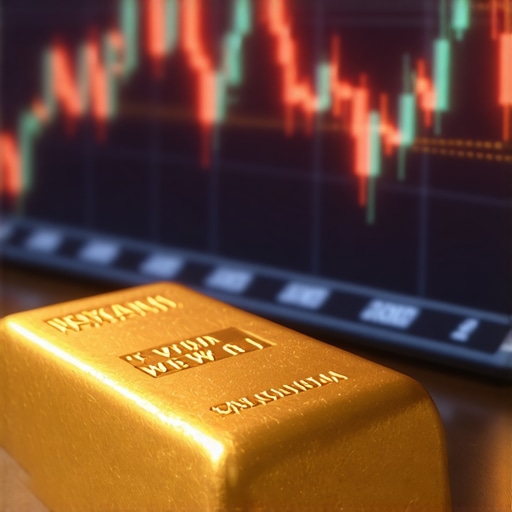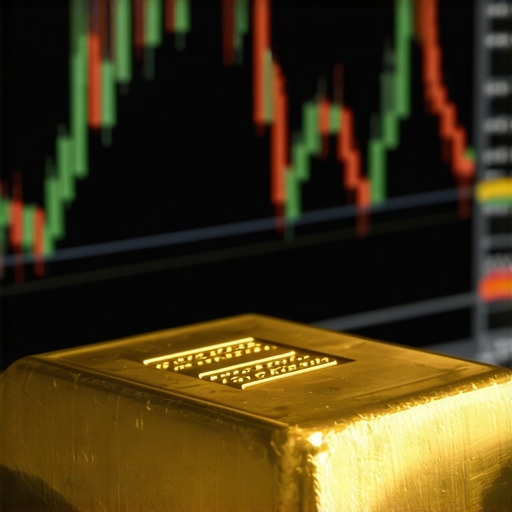Understanding the Gold Price Forecast for 2025
The gold market has always been a focal point for investors, particularly during times of economic uncertainty. As we look towards 2025, understanding the gold price forecast becomes crucial for making informed investment decisions. Analysts and experts are predicting several key trends that could influence gold prices in the coming years.
Economic Factors Influencing Gold Prices
The role of gold as a hedge against inflation and economic downturns is well established. With rising inflation rates and ongoing geopolitical tensions, many investors are turning to gold as a safe-haven asset. The dynamics of supply and demand, along with central bank policies, will play a significant role in shaping gold prices.
In 2025, we anticipate that central banks will continue their trend of accumulating gold reserves as part of their monetary strategy. This increased demand from banks may lead to a constriction in supply, putting upward pressure on gold prices. Furthermore, as more investors seek to diversify their portfolios, the demand for gold is likely to rise.
Technological Advancements in Gold Trading
Technological advancements are also reshaping the way investors approach gold trading. The rise of digital platforms and gold ETFs has made it easier for individuals to invest in gold without the need for physical ownership. This trend is expected to continue and could impact gold prices positively, as more investors gain access to gold trading.
Market Sentiment and Speculation
Market sentiment plays a critical role in gold price movements. As we approach 2025, the psychological factors affecting investor behavior will be vital to monitor. Economic forecasts, political stability, and global financial health will all influence how investors perceive gold’s value. In times of uncertainty, the tendency is to gravitate towards gold, which historically holds its value well.
Additionally, speculative trading can lead to fluctuations in gold prices. Traders often react to news and global events, which can cause sharp movements in gold prices. For instance, if inflation fears escalate, speculative buying could push prices higher as investors seek to capitalize on potential gains.
Conclusion: Preparing for the Future of Gold Investment
As we look ahead to 2025, it is essential for investors to stay informed about the trends influencing gold prices. By understanding economic factors, technological advancements, and market sentiment, investors can better position themselves in the gold market. For those interested in diversifying their investment portfolio, exploring options like gold IRAs and gold mining stocks could offer significant opportunities.
Gold Demand Trends for 2025: What Investors Should Know
As we delve deeper into the gold price forecast for 2025, it’s vital to examine the demand trends that could significantly influence market dynamics. The demand for gold is often shaped by various factors, including consumer preferences, economic conditions, and investment trends. In 2025, we anticipate a robust demand from both retail investors and institutional buyers, driven by the ongoing search for security in volatile markets.
Inflation and Currency Instability
Inflationary pressures are expected to continue influencing gold demand. As the cost of living rises and currencies fluctuate, gold remains an attractive hedge. Investors are likely to flock to physical gold and gold coins as they seek stability amidst uncertainty. Understanding how inflation impacts purchasing power will be crucial for those considering investment in gold.
The Role of Central Banks in Gold Demand
Central banks are predicted to play a pivotal role in driving gold demand in 2025. Many central banks have been actively increasing their gold reserves as part of their monetary policy strategies. This trend not only stabilizes their national currencies but also serves as a counterbalance to fluctuating global economies. The benefits of central bank gold purchases are significant, and their influence on gold prices cannot be overstated.
Exploring Different Gold Investment Vehicles
Investors in gold have a multitude of options available to them. From gold bullion to ETFs and coins, each investment vehicle offers unique advantages and risks. As we approach 2025, understanding these options will be essential for making informed decisions.
Gold ETFs: A Modern Approach to Gold Investment
Gold Exchange-Traded Funds (ETFs) have gained popularity among younger investors due to their ease of access and liquidity. These investment vehicles allow investors to gain exposure to gold prices without the hassle of physical storage. For a detailed overview, check out our guide on investing in gold ETFs.
Physical Gold vs. Digital Gold: Making the Right Choice
When deciding between physical gold and digital alternatives, it’s crucial to evaluate personal investment goals and risk tolerance. Each option comes with its own set of benefits, and understanding these differences can enhance your investment strategy. For those leaning towards tangible assets, exploring the top strategies for buying gold coins can be highly beneficial.
Investment Strategies for Gold: Why Timing Matters
Timing can make a significant difference in the performance of gold investments. Investors should be aware of market cycles and economic indicators that could signal optimal buying opportunities. Learning to navigate these cycles can enhance your potential returns. For insights on effective strategies, refer to our post on gold investment strategies.
Understanding Market Cycles
Market cycles can greatly affect the value of gold. Investors should stay informed about global economic trends, geopolitical events, and market sentiment to better understand when to enter or exit positions. Keeping an eye on gold price forecasts will provide valuable insights into potential market movements.
Conclusion: Positioning for Success in Gold Investment
In conclusion, 2025 presents a unique landscape for gold investment. By understanding demand trends, evaluating different investment vehicles, and recognizing the importance of timing, investors can position themselves for success in the evolving gold market. For those looking to explore retirement options, consider our insights on gold IRA options as an effective way to secure your financial future.
Current Gold Price Influencers: What to Watch This Year
As we examine the current gold price influencers, it’s crucial to understand the multifaceted factors that drive the fluctuations in gold prices. Investors should keep a close watch on various elements, from geopolitical tensions to changes in interest rates, as these can have significant impacts on the gold market. By staying informed, investors can make strategic decisions that align with market movements.
Geopolitical Events and Their Impact on Gold Prices
Geopolitical tensions often lead to increased demand for gold as a safe-haven asset. Events such as international conflicts, trade wars, and political instability can create uncertainty, prompting investors to turn to gold to protect their wealth. For a deeper understanding of how such events influence the market, consider reviewing our analysis on the impact of economic events on gold prices. As we approach 2025, monitoring global news will be essential for anticipating shifts in gold demand.
The Role of Interest Rates in Gold Valuation
Interest rates play a pivotal role in the valuation of gold. Typically, when interest rates rise, the opportunity cost of holding non-yielding assets like gold increases, which can lead to a decrease in its price. Conversely, lower interest rates make gold more attractive as an investment. Understanding how central banks’ decisions affect interest rates will help investors gauge potential price movements. For more insights, refer to our post on how central bank actions affect gold prices.
Evaluating Supply and Demand Dynamics in Gold Markets
The dynamics of supply and demand significantly influence gold prices. A strong demand from industrial sectors, alongside retail and investment demand, can exert upward pressure on prices. On the supply side, mining production levels and geopolitical stability in gold-producing regions can impact availability. For a comprehensive overview, check out our article on key trends in gold supply and demand moving forward.
Gold Mining Production Levels
Gold mining production levels are a critical factor in understanding price trends. Any disruptions in mining operations due to natural disasters, labor strikes, or regulatory changes can lead to a decrease in gold supply, thereby affecting prices. Staying updated on the status of major mining companies and their production forecasts will provide insights into future market conditions. For those interested in more about mining, consider exploring our guide on investing in gold mining stocks.
Investment Trends and Their Effects on Gold Prices
Investment trends, particularly among institutional investors, can also influence gold prices. As institutional investments in gold increase, the demand can lead to higher prices. Tracking the movements of large hedge funds and investment firms can provide valuable insights into upcoming price changes. For a detailed discussion on investment strategies, refer to our post on gold investment strategies.
Conclusion: Preparing for Future Gold Investment Opportunities
In conclusion, understanding the current gold price influencers is vital for successful gold investment. From geopolitical events and interest rates to supply and demand dynamics, staying informed about these factors will enhance your investment strategy. As 2025 approaches, consider exploring various investment vehicles, such as gold IRA options and gold ETFs, to diversify your portfolio and capitalize on market opportunities.
Understanding Economic Events and Their Impact on Gold
Economic events are a significant driver of gold prices. Investors should be aware of how various economic indicators and announcements can influence the market. Key events such as employment reports, inflation data, and GDP growth rates can signal changes in economic health, subsequently affecting gold’s appeal as a safe-haven asset.
Employment Reports and Their Influence on Gold Prices
Employment reports, particularly the Non-Farm Payrolls (NFP) report in the United States, can lead to substantial market movements. A strong jobs report typically signals economic strength, which may decrease gold’s attractiveness as it increases the likelihood of interest rate hikes. Conversely, a weak report can lead to a surge in gold prices as investors seek safety. For a better understanding of this correlation, refer to our analysis of current gold price factors.
Inflation Data and Gold Investment
Inflation is another critical factor influencing gold prices. Historically, gold has been viewed as a hedge against inflation. When inflation rates rise, the purchasing power of currency declines, leading investors to flock to gold to preserve their wealth. Monitoring the Consumer Price Index (CPI) and other inflation indicators will provide insights into potential gold price increases. For more information on how inflation affects gold, check out assessing the impact of inflation on gold demand.
Gold as a Safe Haven During Economic Uncertainty
During times of economic uncertainty, gold often shines as a safe haven. Investors typically turn to gold during market downturns or when there is volatility in the financial markets. Understanding the historical context of gold as a protective asset can help investors make informed decisions about when to enter the market.
The Psychology of Investors and Gold Prices
The psychology of investors plays a crucial role in the demand for gold. Fear and uncertainty can drive investors to seek out gold, pushing prices higher. This phenomenon is often observed during financial crises, where the fear of losing financial stability leads to increased buying of gold. For a deeper dive into this psychological aspect, explore our article on the psychology behind gold prices.
Central Bank Policies and Their Effects on Gold Demand
Central banks around the world hold substantial gold reserves, and their policies can greatly impact gold prices. When central banks increase their gold holdings, it often signals confidence in gold as a stable asset. Additionally, policies regarding interest rates and monetary supply can influence gold’s attractiveness. For insights into how central banks shape gold demand, refer to our post on the impact of central banks on gold investment trends.
Conclusion: Navigating Economic Events in Gold Investment
In summary, understanding economic events and their impact on gold prices is essential for investors looking to navigate the gold market effectively. By paying attention to employment reports, inflation data, and central bank policies, investors can make informed decisions. As economic conditions evolve, the role of gold as a protective asset remains steadfast. For those looking to explore various gold investment options, consider checking out our resources on best gold investments for beginners and a comprehensive guide to buying gold. By keeping abreast of these economic indicators, investors can strategically position themselves for the future.
Understanding Economic Events and Their Impact on Gold
Economic events are a significant driver of gold prices. Investors should be aware of how various economic indicators and announcements can influence the market. Key events such as employment reports, inflation data, and GDP growth rates can signal changes in economic health, subsequently affecting gold’s appeal as a safe-haven asset.
Employment Reports and Their Influence on Gold Prices
Employment reports, particularly the Non-Farm Payrolls (NFP) report in the United States, can lead to substantial market movements. A strong jobs report typically signals economic strength, which may decrease gold’s attractiveness as it increases the likelihood of interest rate hikes. Conversely, a weak report can lead to a surge in gold prices as investors seek safety. For a better understanding of this correlation, refer to our analysis of current gold price factors.
Inflation Data and Gold Investment
Inflation is another critical factor influencing gold prices. Historically, gold has been viewed as a hedge against inflation. When inflation rates rise, the purchasing power of currency declines, leading investors to flock to gold to preserve their wealth. Monitoring the Consumer Price Index (CPI) and other inflation indicators will provide insights into potential gold price increases. For more information on how inflation affects gold, check out assessing the impact of inflation on gold demand.
Gold as a Safe Haven During Economic Uncertainty
During times of economic uncertainty, gold often shines as a safe haven. Investors typically turn to gold during market downturns or when there is volatility in the financial markets. Understanding the historical context of gold as a protective asset can help investors make informed decisions about when to enter the market.
The Psychology of Investors and Gold Prices
The psychology of investors plays a crucial role in the demand for gold. Fear and uncertainty can drive investors to seek out gold, pushing prices higher. This phenomenon is often observed during financial crises, where the fear of losing financial stability leads to increased buying of gold. For a deeper dive into this psychological aspect, explore our article on the psychology behind gold prices.
Central Bank Policies and Their Effects on Gold Demand
Central banks around the world hold substantial gold reserves, and their policies can greatly impact gold prices. When central banks increase their gold holdings, it often signals confidence in gold as a stable asset. Additionally, policies regarding interest rates and monetary supply can influence gold’s attractiveness. For insights into how central banks shape gold demand, refer to our post on the impact of central banks on gold investment trends.
Frequently Asked Questions About Gold Investment
What are the key factors influencing gold prices?
The key factors influencing gold prices include economic indicators such as employment reports, inflation data, central bank policies, and geopolitical events that create market uncertainty.
How does inflation affect gold investment?
Inflation affects gold investment by decreasing the purchasing power of currency, prompting investors to buy gold as a hedge against rising prices and to preserve their wealth.
Why is gold considered a safe haven asset?
Gold is considered a safe haven asset because it tends to retain its value during economic downturns and financial crises, providing a sense of security to investors.
What role do central banks play in gold prices?
Central banks influence gold prices through their buying and selling activities, as well as their monetary policies, which can increase or decrease gold’s attractiveness as an investment.
How can I monitor economic events that affect gold prices?
Investors can monitor economic events that affect gold prices by following economic calendars, financial news, and reports on employment, inflation, and central bank decisions.
What historical events have significantly impacted gold prices?
Historical events that have significantly impacted gold prices include the 2008 financial crisis, the COVID-19 pandemic, and geopolitical tensions, all of which drove investors to seek safety in gold.
Is investing in gold a good long-term strategy?
Investing in gold can be a good long-term strategy as it often serves as a hedge against inflation and economic instability, helping to diversify an investment portfolio.
What types of gold investments are available?
Types of gold investments include physical gold (coins and bars), gold ETFs (exchange-traded funds), mining stocks, and gold mutual funds.
How can I start investing in gold?
To start investing in gold, research different forms of gold investments, choose a reputable dealer or platform, and consider your investment goals and risks before making purchases.
Conclusion: Navigating Economic Events in Gold Investment
In summary, understanding economic events and their impact on gold prices is essential for investors looking to navigate the gold market effectively. By paying attention to employment reports, inflation data, and central bank policies, investors can make informed decisions. As economic conditions evolve, the role of gold as a protective asset remains steadfast. For those looking to explore various gold investment options, consider checking out our resources on best gold investments for beginners and a comprehensive guide to buying gold. By keeping abreast of these economic indicators, investors can strategically position themselves for the future.










